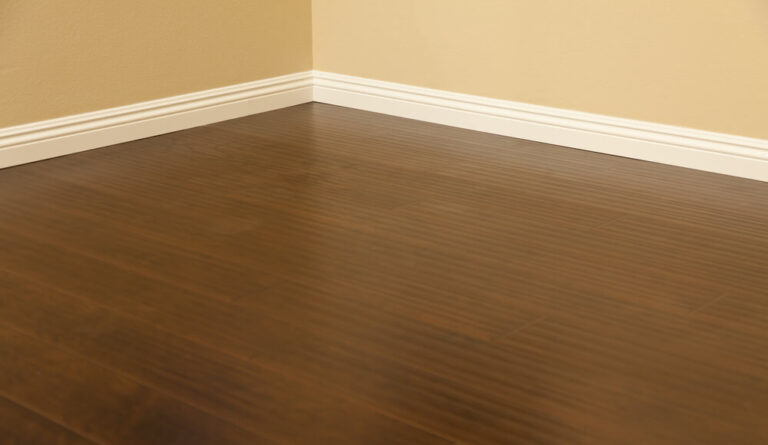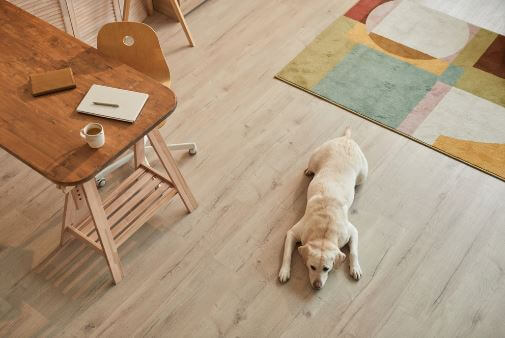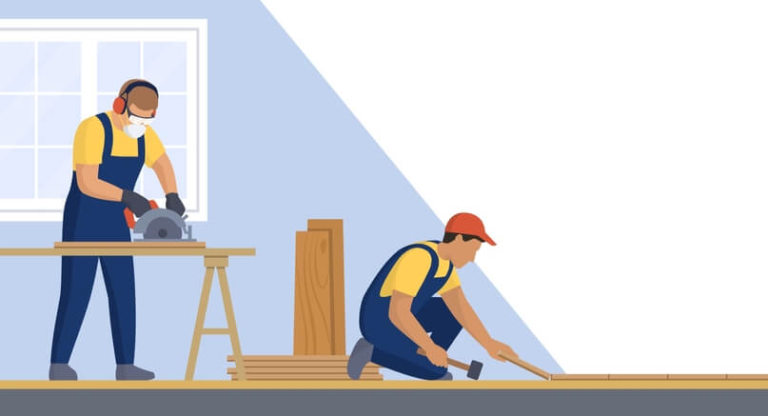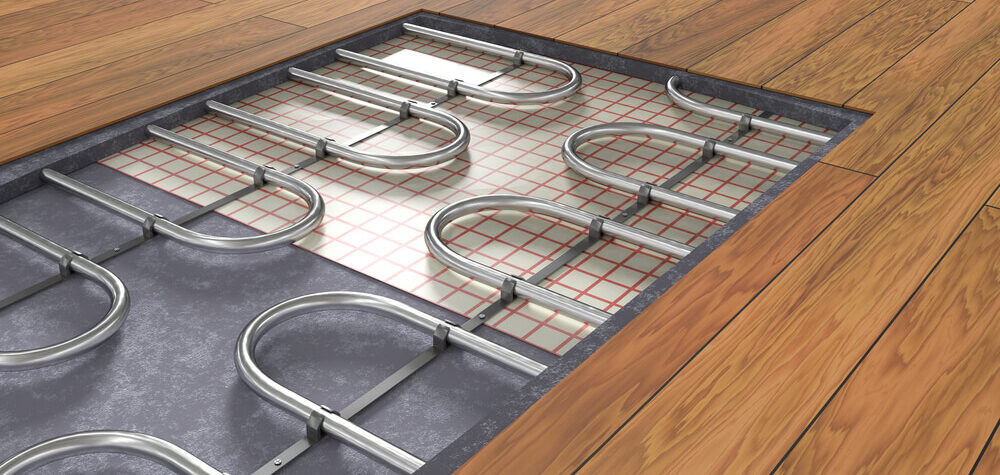
Gone are the days when chilly wood floors were a norm during the winter months. With the advent of radiant heat, you can enjoy warm, toasty feet even in the coldest of seasons. But can you put radiant heat under wood floors?
Yes, radiant heating can be placed under hardwood floors. In fact, wood floors are an excellent choice for radiant heat systems, providing both comfort and aesthetic appeal.
In this article, we have discussed every sizzling detail about wood floors with radiant heat, its working principle, installation, benefits, and some cons.
Before moving into the details of radiant heat under the hardwood floor it is necessary to know?
How Radiant Heating System Works?
Radiant heat is the unsung hero of home heating. It operates on the principle of heating objects directly, as opposed to warming the air. This system emits thermal energy directly from the floor’s surface, gently and evenly warming the room from the ground up. This system is a great option for wooden floors as it provides a consistent and uniform warmth throughout the room, eliminating cold, and causes no foot pain.
Can You Put Radiant Heat Under Wood Floors?
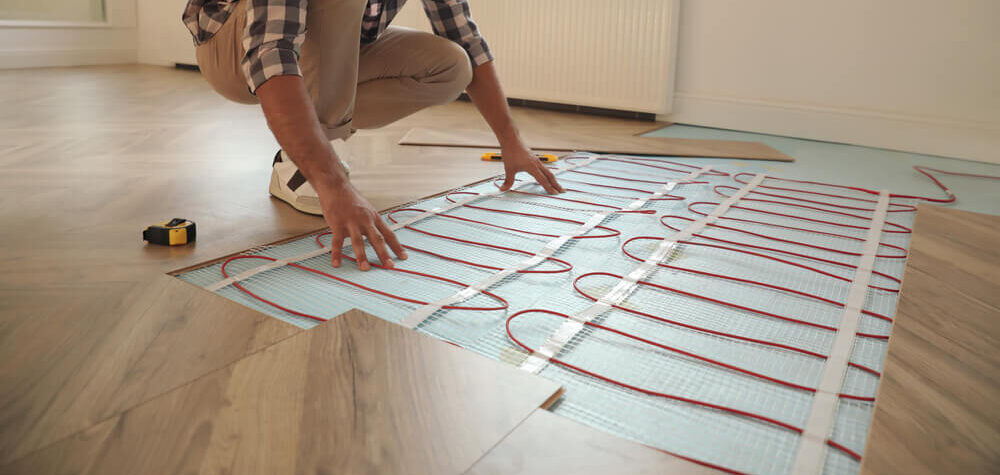
Yes, you can indeed install radiant heating systems under wood floors. However, it’s not a one-size-fits-all scenario. It depends on the type of wood, the installation method, and the heating system itself.
What Is The Best Flooring To Use With Underfloor Heating?
Engineered hardwood flooring is generally the best choice for underfloor heating, as it is more stable and less prone to moisture damage than solid hardwood. However, certain types of solid hardwood, such as oak, maple, and cherry, can also work well with underfloor heating if they are properly installed and maintained.
How Thick Can A Wood Floor Be For Radiant Heat?
The maximum thickness of a wood floor for radiant heat is typically around 18mm (0.71 inches). Thicker wood floors may not allow heat to transfer efficiently and could potentially warp or crack due to temperature fluctuations.
What Temperature Should Wood Floors Be Radiant?
The ideal temperature for radiant heating under wood floors is between 72°F and 80°F (22°C and 27°C). This range provides comfortable warmth without exceeding the recommended temperature limit for most hardwood species, which is typically around 80°F (27°C) to prevent damage.
What Is The Best Underfloor Heating For Wooden Floors?
Hydronic radiant heating is generally considered the best option for wooden floors, as it provides a more consistent and uniform heat distribution compared to electric radiant heating. Hydronic systems also tend to be more energy efficient and cost-effective in the long run.
How Do You Prepare A Floor For Radiant Heat?
Proper preparation of the subfloor is crucial for ensuring the successful installation of radiant heat under wood floors. This involves ensuring the subfloor is level and smooth, installing a vapor barrier to prevent moisture damage, and securing the radiant heating elements to the subfloor according to the manufacturer’s instructions.
Things To Consider Before Installing Radiant Floor Heating Under Hardwood

When planning to add radiant heating under hardwood floors, a few important things need your attention. Let’s break it down:
1. Type of Hardwood
Choose hardwood that handles temperature changes well. Engineered wood is often a good pick because it’s more stable and less prone to moisture damage than solid hardwood.
2. Subfloor Condition
Ensure your subfloor is in top-notch condition. It should be flat, dry, and free from any issues to avoid future problems. You can also add a vapor barrier, which is a sheet of plastic that is installed beneath the subfloor to prevent moisture from rising from the ground. This is especially important in areas with high humidity levels.
3. Heating System Compatibility
Different radiant heating systems work with hardwood. Hydronic or electric – make sure your chosen system suits both your flooring and heating needs.
4. Temperature Control
Consider how you want to control the temperature. Different systems offer various control options. Pick one that fits your lifestyle. According to research, design and layout of the radiant heating system under wood floors is also closely related to temperature.
5. Budget
Know your budget. Radiant floor heating can be an investment, so plan accordingly. Factor in the system, installation, and any adjustments needed for your hardwood.
6. Maintenance
Understand the maintenance requirements. Luckily, radiant heat systems are generally low-maintenance, but it’s good to know what to expect. You can also use a thermostat to control the temperature of the radiant heat system. This will allow you to adjust the temperature as needed to maintain a comfortable environment.
By considering these aspects, you pave the way for a cozy, efficient, and enduring blend of hardwood flooring and radiant warmth in your home.
How To Install Radiant Heat Under Hardwood Floors?

Enhance your home with cozy warmth by installing radiant heat under hardwood floors. Follow these steps for a seamless integration:
- Begin by assessing your space. Evaluate the type of hardwood and subfloor. Plan the layout of the radiant tubing or electric mats, considering even spacing for consistent heating.
- Ensure your subfloor is in top condition. It should be clean, level, and dry. Address any issues like unevenness or moisture problems to prevent future complications.
- Install insulation between the subfloor and the heating system. This ensures that the heat travels upward, optimizing energy efficiency. Use appropriate insulation materials compatible with your radiant heat system.
- For hydronic systems, secure the tubing according to the planned layout. For electric systems, lay the mats or cables as per the manufacturer’s guidelines. Ensure precise installation to avoid any damage to the heating elements.
- Connect the radiant heating system to the heat source. For hydronic systems, this involves linking the tubing to the boiler. Electric systems require proper connection to the power source. Follow manufacturer instructions diligently.
- Before covering the heating elements, conduct thorough testing. Check for leaks in hydronic systems and ensure the electric system operates as expected. Address any issues promptly to avoid complications later on.
- Once the radiant heating system is confirmed operational, cover it with a thin layer of self-leveling compound or thinset mortar. This provides a smooth surface for the hardwood flooring.
- Install the hardwood flooring using the appropriate method for your chosen flooring type. Follow manufacturer guidelines for acclimation, spacing, and installation to maintain the integrity of both the flooring and heating system.
- After the hardwood installation, perform final checks on the heating system. Ensure all components are functioning correctly. Make necessary adjustments to the temperature controls for optimal comfort.
By following these steps meticulously, you ensure a successful installation, creating a home environment that’s not only aesthetically pleasing but also wonderfully warm.
Can You Install Radiant Heat Under The Existing Floor?
Yes, you can install radiant heat under an existing floor in many cases. The two most common methods are staple-up and hydronic.
Staple-up radiant heat is the most common method for retrofitting radiant heat under an existing floor. This method involves attaching aluminum heat transfer plates to the underside of the subfloor. PEX tubing is then stapled to the heat transfer plates and hot water is circulated through the tubing to heat the floor.
Hydronic radiant heat can also be retrofitted under an existing floor. This method involves installing a layer of hydronic mats or tubing between the subfloor and the finished floor. Hot water is then circulated through the mats or tubing to heat the floor.
Some Other Considerations
The type of subfloor
Staple-up radiant heat can be installed under most types of subfloors, including wood, plywood, and concrete. Hydronic radiant heat can be installed under wood and plywood subfloors, but it is not recommended for concrete subfloors.
The height of the joists
The joists in your floor need to be at least 2 inches deep to accommodate staple-up radiant heat. Hydronic radiant heat can be installed under joists that are as shallow as 1 inch.
The condition of the subfloor
The subfloor must be in good condition and free of damage. If the subfloor is damaged, it will need to be repaired before radiant heat can be installed.
Disadvantages Of Radiant Heating Systems Under Hardwood Floors

While radiant heating systems offer numerous advantages for homeowners, they also present some drawbacks that should be considered before installation. Here are some of the disadvantages of radiant heating systems under hardwood floors:
High Initial Cost
Radiant heating systems are generally more expensive to install than traditional forced-air or baseboard heating systems. This is due to the cost of materials, labor, and specialized equipment involved in the installation process.
Slow Heat Response
Radiant heating systems take longer to heat up a room compared to forced-air systems. This is because they rely on gradually warming the floor material, which then radiates heat into the room. This can be a disadvantage in cold climates where a quick heating response is desired.
Potential for Wood Damage
Improper installation or moisture control issues can lead to damage to hardwood flooring. Excessive heat or moisture can cause the wood to warp, crack, or buckle.
Maintenance Requirements
Radiant heating systems require regular maintenance to ensure optimal performance and prevent issues. This may include checking water pressure or bleeding air from the system.
Complexity of Installation
Installing radiant heating systems under hardwood floors requires a certain level of expertise and specialized tools. DIY projects are not recommended for inexperienced individuals.
Limited Suitability for Certain Woods
Not all hardwood species are equally compatible with radiant heating systems. Some woods, such as maple and oak, are more suitable, while others may be more prone to moisture damage or warping.
Potential for Noise
Hydronic radiant heating systems may produce a slight ticking or gurgling sound as the water circulates through the pipes. This noise or creak at night is usually minimal and may not be noticeable in most homes.
Potential for Uneven Heating
If the radiant heating system is not installed evenly or if there are air pockets in the tubing, the heat distribution may be uneven, resulting in some areas being warmer than others.
FAQs

What Flooring Is Not Suitable For Underfloor Heating?
Laminate flooring is generally unsuitable for underfloor heating due to its composition, as it may warp or separate. Natural materials like stone and ceramic tiles are preferable, ensuring efficient heat transfer without compromising the integrity of the flooring.
How To Install Electric Radiant Floor Heating Under Hardwood?
Begin by ensuring a level subfloor. Lay the electric radiant mats or cables, securing them per manufacturer guidelines. Cover with a thinset mortar and install the hardwood flooring. Professional installation is advisable for precision and to prevent damage to the heating elements.
How To Install Hydronic Radiant Floor Heating Under Hardwood?
Prioritize a stable, moisture-resistant subfloor. Install the hydronic tubing securely, ensuring even spacing for consistent heating. Cover the tubing with a self-leveling compound or thinset mortar. Once dry, install the hardwood flooring using the appropriate method. Professional expertise is recommended for a flawless integration.
What Is The Best Subfloor For Radiant Heat?
Plywood and OSB (oriented strand board) are excellent subfloor choices for radiant heat. They provide a stable surface, crucial for preventing heat loss. Ensure proper insulation between the subfloor and the heating system. Consulting with a professional ensures the ideal subfloor material and configuration for your specific radiant heating setup.
Conclusion
Yes, you can put radiant heat under wood floors. In fact, it’s a great option for providing even, comfortable heat throughout your home. Radiant heat systems work by circulating hot water or electricity through tubes or mats embedded beneath the floor. This heat is then transferred to the wood flooring, which radiates it into the room. If you still have any questions, feel free to comment down below, we will be happy to assist you further.

